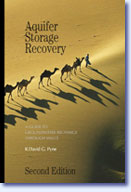


 |
||
|
|
||
Every so often, my intention is to add some comments regarding new issues, questions, solutions and other items that may arise regarding ASR, in response to web page response, voicemail, snail mail, my own experiences and other sources. These will necessarily be brief, but may provide a starting point for further discussion.
1. Target Storage Volume (TSV)
People often ask how much water do they get back from an ASR well compared to how much they recharge. We call this "recovery efficiency," or the volume of water that you recover divided by the volume recharged. The TSV is an estimate of the volume that has to be placed into storage so that the recovery efficiency is 100%, or as close to 100% as the site can achieve. It is a concept that has evolved during the past few years and is still evolving.
 The TSV is composed of two parts: the volume actually needed for recovery, plus the volume needed in the buffer zone separating the storage bubble from the native water quality in the aquifer. If the surrounding native water quality is excellent, the buffer zone volume may be quite small. However, if the surrounding aquifer is very poor water quality, the buffer zone volume may be large. Once the TSV is reached, it should theoretically be possible to recover the full amount needed. In past years, the TSV was achieved over a period of several operating cycles, during each of which the recovery efficiency steadily increased, approaching and finally reaching 100% in almost all cases. Now we recognize that the cumulative volume stored underground and not recovered in this series of initial operating cycles can be placed into storage at one time, tremendously reducing the time required and cost to achieve full recovery efficiency at each site. The trick is to estimate the TSV.
The TSV is composed of two parts: the volume actually needed for recovery, plus the volume needed in the buffer zone separating the storage bubble from the native water quality in the aquifer. If the surrounding native water quality is excellent, the buffer zone volume may be quite small. However, if the surrounding aquifer is very poor water quality, the buffer zone volume may be large. Once the TSV is reached, it should theoretically be possible to recover the full amount needed. In past years, the TSV was achieved over a period of several operating cycles, during each of which the recovery efficiency steadily increased, approaching and finally reaching 100% in almost all cases. Now we recognize that the cumulative volume stored underground and not recovered in this series of initial operating cycles can be placed into storage at one time, tremendously reducing the time required and cost to achieve full recovery efficiency at each site. The trick is to estimate the TSV.
Initial operating experience at several sites is providing an ever-improving basis for estimation of the TSV. Usually, this is expressed in terms of days of recovery capacity. For example, the West Wellfield ASR system for Miami-Dade Water & Sewer Department, Florida, recently tested its first of five new ASR wells. A TSV of 70 days of recovery capacity was estimated for this 5-MGD ASR well, storing untreated groundwater in a brackish, limestone artesian aquifer. The storage zone is about 120 m (400 ft) thick and has an estimated transmissivity ofabout 118,000 gpd/ft.
 Groundwater quality in the storage zone is about 4000 mg/l total dissolved solids, or eight times the drinking water standards for salt content. The water source for recharge is a shallow overlying aquifer containing fresh water. The TSV was first formed by recharging 1,325 Ml (350 MG), following which the first operating cycle was conducted, recovering 132 Ml (35 MG) with only a slight increase in chloride concentration, from 60 mg/l during recharge to 80 mg/l at the end of recovery. 100% recovery efficiency was achieved on the first cycle. It appears that a smaller TSV would have been sufficient at this well.
Groundwater quality in the storage zone is about 4000 mg/l total dissolved solids, or eight times the drinking water standards for salt content. The water source for recharge is a shallow overlying aquifer containing fresh water. The TSV was first formed by recharging 1,325 Ml (350 MG), following which the first operating cycle was conducted, recovering 132 Ml (35 MG) with only a slight increase in chloride concentration, from 60 mg/l during recharge to 80 mg/l at the end of recovery. 100% recovery efficiency was achieved on the first cycle. It appears that a smaller TSV would have been sufficient at this well.
At other sites in similar karst limestone aquifers, TSV estimates range from a high of about 350 days of recovery capacity to a low of about 50 days. In granular aquifers, the TSV estimates should be much lower.
 The TSV is usually developed using readily available water during offpeak periods when demand is relatively low and supplies may be substantial. The cost of developing a TSV at such times is usually just the marginal cost of the water, including electrical power and chemicals. In most situations this cost is quite low. Where water for the TSV has to be purchased at high cost regardless of its availability, formation of the buffer zone can be expensive, perhaps justifying consideration of other interim water sources for buffer zone formation.
The TSV is usually developed using readily available water during offpeak periods when demand is relatively low and supplies may be substantial. The cost of developing a TSV at such times is usually just the marginal cost of the water, including electrical power and chemicals. In most situations this cost is quite low. Where water for the TSV has to be purchased at high cost regardless of its availability, formation of the buffer zone can be expensive, perhaps justifying consideration of other interim water sources for buffer zone formation.
Several factors comprise the estimation of the TSV. These include native water quality, aquifer thickness, confinement, effective porosity, transmissivity, hydraulic gradient, variability in source water availability and variability in recovered water demand. The TSV is clearly applicable for situations where mixing and dispersion are the predominant mechanisms for changes in water quality underground during storage. It is less applicable in situations where geochemical reactions occur underground that can affect recovered water quality, where the natural or imposed hydraulic gradient in the storage zone reduces recovery efficiency, or where the storage zone contains native water so brackish that a significant density difference exists between the recharge water and the native groundwater.
what is ASR / where is ASR / issues/solutions / team ASR / resources / links / contact

Aquifer Storage Recovery
By David Pyne
This is the only book published on aquifer storage recovery (ASR), a cost-effective water storage technology that has evolved rapidly during the past 25 years and is now being applied throughout the world.

